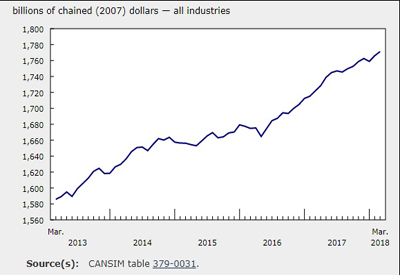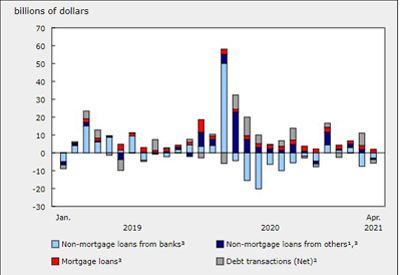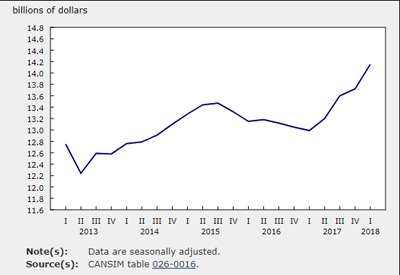GDP Rose 0.3% in March; Wholesale, Retail Trade Up 0.8%

June 18, 2018
Real gross domestic product (GDP) rose 0.3% in March as 15 of 20 industrial sectors grew, led by the mining, quarrying, and oil and gas extraction sector.
The output of goods-producing industries expanded 0.6%, mostly attributable to mining, quarrying, and oil and gas extraction. Manufacturing edged up while construction edged down.
Services-producing industries were up 0.2%, as increases in most sectors more than offset a decline in the finance and insurance sector.
Mining, quarrying, and oil and gas extraction continues to lead growth
The mining, quarrying and oil and gas extraction sector expanded 1.9% in March as all subsectors grew.
The oil and gas extraction subsector was up 2.1%, the fourth increase in five months. Non-conventional oil extraction rose 3.1% as crude bitumen extraction in Alberta reached a record high 8.9 million cubic metres. Conventional oil and gas extraction rose 1.3% as growth in natural gas extraction more than offset a decline in conventional crude petroleum extraction.
Mining excluding oil and gas extraction (+0.8%) was up for a second month in a row after four months of declines. Non-metallic mineral mining rose 2.1% as all industries increased, led by potash mining (+2.8%). Metal ore mining edged up 0.1%, following four months of declines, as growth in iron ore (+8.9%) and gold and silver ore (+1.0%) mining more than offset a seventh consecutive decline in copper, nickel, lead and zinc mining (-4.7%) and other metal ore mining (-2.1%).
Support activities for mining and oil and gas extraction grew 2.1% in March as demand for drilling services increased.
Wholesale and retail trade up
Wholesale trade rose 0.8% in March, offsetting the 0.8% decline in February, as six of nine subsectors grew. Building material and supplies wholesaling (+3.4%) led the growth, as all industry groups increased. Motor vehicle and parts wholesaling was up 2.9%, as motor vehicle wholesaling rose for the first time in four months on the strength of increased imports of passenger cars and light trucks.
Increased sales of imported motor vehicles contributed to the 0.6% rise in retail trade. Higher activity at new car dealers was the main reason for the gain. In retail trade, 7 of 12 subsectors were up, with notable increases in clothing and clothing accessories stores (+1.9%) and general merchandise stores (+1.6%). Gasoline stations (-1.9%) declined for a third consecutive month.
Transportation and warehousing continues to grow
Higher output of natural gas and crude oil was a major contributor to the 0.8% increase in transportation and warehousing in March. Overall, seven of nine subsectors increased.
Pipeline transportation rose 5.6% in March, following a 0.8% decline in February. Pipeline transportation of natural gas (+7.9%) and crude oil and other pipeline transportation (+3.3%) both rose on higher exports to the United States.
Rail transportation increased 0.2% following two months of decline, as higher carloadings of grain and fertilizers and coal more than offset lower carloadings of metals and minerals and industrial and consumer products.
Air transportation (+0.5%) rose for a third consecutive month, while truck transportation increased 0.4%.
The largest monthly contraction in the finance and insurance sector in nine years
Following four months of growth, the finance and insurance sector declined 1.2% in March, the largest monthly contraction since November 2008.
An atypical decline in stock market trading activity in March was the main reason for the decreases in depository credit intermediation and monetary authorities (-1.0%) and financial investment services, funds and other financial vehicles (-3.2%). Insurance carriers and related activities (-0.5%) declined for the first time since October 2017 on lower premium revenue.
Manufacturing edges up
The manufacturing sector edged up 0.1% in March. The 0.3% growth in non-durable manufacturing was mostly offset by a 0.1% decrease in durable manufacturing.
Growth in non-durable manufacturing was led by a 7.0% increase in plastic and rubber products as plastic manufacturers built up their inventories. Chemical products manufacturing rose 2.9% with increases in most industry groups. Food manufacturing was down 2.5% as most industry groups declined.
In durable manufacturing, 6 of 10 subsectors increased. Machinery (-4.1%) manufacturing declined for the first time in five months. There were also declines in computer and electronic products (-2.0%) and electrical equipment (-1.8%) manufacturing, while transportation equipment (+1.2%), primary metal (+1.3%), miscellaneous (+2.8%) and wood products (+0.7%) manufacturing increased.
Construction edges down
Construction (-0.1%) was down slightly in March as declines in residential (-0.7%) and repair (-0.3%) construction offset growth in engineering and other construction activities (+0.4%) and non-residential construction (+0.6%).
Other industries
Real estate and rental and leasing edged up 0.1% in March following two months of declines. Activity at the offices of real estate agents and brokers (-1.8%) decreased for the third month in a row, following the implementation of new mortgage lending rules in January, including stress-testing for uninsured mortgages.
Professional, scientific and technical services expanded 0.4% as most industries grew. Computer systems design (+1.2%) continued to be one of the fastest-growing industries in the economy. Legal services declined 2.0% in the wake of the cooling real estate market and lower stock market activity.
The public sector was up 0.2% with all three components (education, health care and public administration) increasing.
Utilities grew 0.6%. Electric power generation, transmission and distribution rose 0.8% while natural gas distribution edged down 0.1%. Temperatures were seasonal in Eastern Canada while Western Canada was cooler than usual.
Accommodation and food services rose 0.5% as both food services and drinking places (+0.4%) and accommodation services (+0.6%) increased.
Agriculture, forestry, fishing and hunting edged up 0.1%.
First quarter of 2018
The value added of goods-producing industries increased 0.6% in the first quarter, marking seven consecutive quarters of growth, while the value added of services-producing industries rose 0.3%. Growth in both goods-producing and services-producing industries was widespread as 14 of 20 sectors reported gains.
The main contributor to growth in the goods-producing industries was the construction sector (+1.4%), which rose for the sixth consecutive quarter. All components of the sector grew, with non-residential construction (+3.0%) growing at its fastest pace since the third quarter of 2013.
Manufacturing was up 0.4% as durable manufacturing rose 1.2%, while non-durable manufacturing declined 0.7%. Mining, quarrying, and oil and gas extraction was up 0.4%, marking the seventh consecutive quarter of growth. The gain stemmed from increased oil and gas extraction (+0.5%) and support activities for mining and oil and gas extraction (+2.9%), while mining excluding oil and gas declined 1.4%. Utilities rose 0.3% on the strength of a 3.8% rise in natural gas distribution. Agriculture, forestry, fishing and hunting declined 0.2%.
Growth in the services-producing industries was led by the public sector (+0.7%), finance and insurance (+0.8%) and professional, scientific and technical services (+0.9%). In finance and insurance, financial investment services were up 3.4% following declines in the previous two quarters. Transportation and warehousing rose 1.0% with increases in most subsectors. Wholesale trade (+0.4%) had its slowest growth in more than a year. Retail trade (-0.9%) registered its first quarterly decline since the second quarter of 2016. The output of real estate agents and brokers (-13.7%) fell to its lowest level since the first quarter of 2014.
Source: Statistics Canada, https://www150.statcan.gc.ca/n1/daily-quotidien/180531/dq180531b-eng.htm











